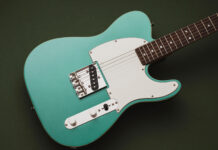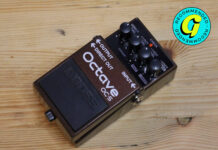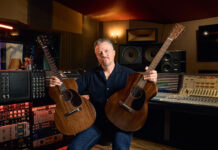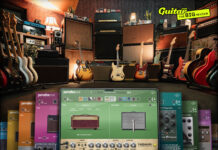
13 best overdrive pedals for guitarists
An overdrive pedal is a must-have on any player’s board. In a (guitar) world of opinions and debates, that’s a statement not many will disagree with. And that’s simply because an overdrive can be a lot of things – there isn’t one single ‘best overdrive’ around.
Metalheads will use it to push the front-end of their high-gain amplifiers. Blues players will take warm, midrange-y units to add sizzle to their solos. Experimental guitarists will exploit an overdrive’s headroom and stack their overdrive pedals with their other effects to whip up crazy sounds. Even straight-up jazz players may use it as a slight boost.
So instead of coming up with a list of a dozen Tube Screamer or Klon clones, we’ve gone with a rainbow of overdrive flavours to suit any musical need. In no particular order, here they are.
Hudson Electronics Broadcast
Type: Overdrive/Boost
Hand-built on stripboard using top-of-the-line components in Hudson Electronics’ Yorkshire workshop, the Broadcast might look like it’s come straight out of a 1960s recording studio, but the ideas displayed inside are innovative and original.
Effectively a preamp based on the classic Neve recording consoles of the 1960s, the Broadcast can behave as both a tone-enhancing clean boost, or a raucous overdrive pedal depending on whether you choose the high- or low-gain option. At its most extreme, it’ll even sound a bit like an old fuzzbox, but without ever losing its refined sonic enhancement and superb touch dynamics.
Also try: Keeley D&M Drive, Fender Santa Ana
ThorpyFX Warthog
Type: Overdrive/Distortion
Adrian Thorpe’s pedals have rapidly acquired a reputation for rigorous build quality and
monster tones, and the Warthog might be the most uncompromising of the lot. Effectively Thorpe’s take on the classic ProCo RAT, the Warthog takes those fabulous overdrive-meets-fuzz tonalities, but ditches the RAT’s over-compressed response that means you’re in danger of disappearing in the mix when playing live.
Instead, you get raw, loud and obnoxious rock tones by the bucketload, which will leave 90s alternative-rock fans wishing they’d owned one in 1994.
Also try: Catalinbread Katzenkönig, TC Electronic Dark Matter
Analog Man King Of Tone
Type: Overdrive
The King Of Tone’s reputation is as much about its scarcity as it is the undeniable quality of the pedal itself. If you want one of Mike Piera’s creations, you’d better not be in a rush – the waiting list is approaching two years and if you can find one second-hand, expect to pay at least double the price of a new one.
Why all the fuss? Well, the likes of Brad Whitford and Jimmy Herring have long prized the King Of Tone for its clear, uncoloured overdrive that enhances, rather than masks, the tone of your signal chain.
The difference between the KoT and that other mythical transparent overdrive, the Klon Centaur, is you can still buy one, though that might not be the case for long, as Piera admits once his stock of required diodes and capacitors are exhausted, he won’t be able to make any more…
Also try: Fulltone OCD, J Rockett Audio Designs Archer
EarthQuaker Devices Westwood
Type: Overdrive
It takes a lot to really stand out in the world of overdrive pedals, but the EarthQuaker Devices Westwood certainly has done since its launch last year. Taking the Tube Screamer as its basis, the Westwood sets itself apart from other green overdrive pedals, offering a wonderfully flattering and subtle natural overdrive sound that compresses like you’d want thanks to its superbly effective tonestack, but without colouring the EQ in any discernible way.
There are plenty of ‘transparent overdrives’ out there, but the Westwood is designed to be ‘translucent’ – and with its sweet, smooth and responsive sound, it’s one of the finest drive pedals on the market today.
Also try: Fulltone OCD, Paul Cochrane Timmy
Fulltone OCD
Type: Overdrive
Michael Fuller debuted the Obsessive Compulsive Drive all the way back in 1994. It’s gone on to become one of the biggest-selling boutique overdrives on the planet, and a go-to for professional players of every stripe. Its party trick is to essentially recreate the sound and (importantly) the feel and response of a cranked amplifier in a pedal.
The OCD has a large dynamic range and offers a continuum of usable sounds – from clean boost to gritty, harmonic-laden fuzzy distortion. The clarity of the OCD has seen players as varied as Robin Trower, Keith Urban, Joey Santiago and Paul Gilbert attracted to its addictive charm and crunch – we’re pretty sure you will be, too.
Also try: Analog Man King Of Tone, EarthQuaker Devices Westwood
Ibanez Tube Screamer Mini
Type: Overdrive
Earlier in this decade, the pedal market experienced what can only be described as a mini-pedal craze, with loads of different brands offering bite-sized versions of their most renowned circuits. Ibanez’s first entry into the format was the Tube Screamer Mini, which crams the classic overdrive circuit into a bijou box for a ridiculously good price.
The best part is, it sounds pretty damn close to a TS808, too. So whether you’re using it as a boost or full-on overdrive, if you’ve ever wanted to find out what all the fuss is about with Tube Screamers, this is a must-buy.
Also try: Electro-Harmonix Soul Food, Boss SD-1
J Rockett Audio Designs Archer Ikon
Type: Overdrive
For sensible money, the Archer Ikon is about the closest you’re going to get to the hallowed sounds of the Klon Centaur, discontinued in 2009. That’s partly because it was created by Chris Van Tassel and Jay Rockett, who worked with Bill Finnegan on his Klon KTR – the follow-up to the Centaur.
As a result, it has a wonderful clean boost that adds a stellar high-end sheen and there’s also plenty of grit on tap if you want it. It’s not cheap, but it offers 95 per cent of the Klon experience for 10 per cent of the price.
Also try: Electro-Harmonix Soul Food, RYRA The Klone
RYRA The Klone
Type: Overdrive
The Klone is the brainchild of Texan solo builder Shane Logan (aka Rock Your Repaired Amp), and as its rather transparent name suggests, its intent is to replicate the famous Klon Centaur overdrive pedal. The Klone gets closer than pretty much all the others, however, perhaps because it’s painstakingly crafted using identical components to the legendary original. For an overdrive pedal, it’s not cheap, but it’s a hell of a lot cheaper than a real Klon will cost you these days.
Also try: J Rockett Audio Designs Archer Ikon, Electro-Harmonix Soul Food
JHS Pedals Morning Glory V4
Type: Overdrive
The Morning Glory is JHS Pedals’ most popular pedal, and the one that first made Josh Scott’s name as a boutique builder to watch when it was created all the way back in 2009. It’s since won Scott a bucketload of awards on the back of its wonderfully transparent quality, which adds everything you’d want to your amp’s sound – sweet overdrive, improved tonal nuance and responsiveness – while retaining the fundamental character of the amp that made you buy it in the first place.
The current fourth iteration also adds a gain-boost toggle to ramp up your solos and lead parts, which can be independently switched with the addition of JHS’ Red Remote.
Also try: J Rockett Audio Designs Archer Ikon, RYRA The Klone
Boss JB-2 Angry Driver
Type: Overdrive
Boss has been making compact effects pedals for 40 years now, and while the company’s iconic stompboxes continue to be a staple of boards the world over, the rise of the boutique builder has made the compact pedal seem a little bland by comparison. In 2018, however, the Japanese giant decided to capture a bit of boutique kudos itself by teaming up with Josh Scott of JHS Pedals to create the Angry Driver.
Effectively a hybrid of Scott’s Angry Charlie and the iconic Boss Blues Driver, the JB-2 is a dual-mode drive pedal that offers a huge palette of overdrive sounds thanks to independent tone-shaping controls for both voices, and the ability to run them independently, in series or parallel.
Also try: Boss BD-2W, Paul Cochrane Timmy
Keeley D&M Drive
Type: Overdrive/Boost
Created with the input of That Pedal Show hosts Mick Taylor and Daniel Steinhardt, the D&M Drive is a twin-voiced overdrive and boost that offers remarkable tonal versatility in a relatively compact two-switch pedal.
The boost side of things offers everything from a rich, midrange bluesy boost all the way to a dynamic overdrive with wonderful touch sensitivity, while the drive side of the equation runs the gamut from valve-like overdrive to searing rock leads. With the ability to alter their signal order as you run them together adding even more sonic options to the mix, the D&M Drive could replace two or even three pedals on your board.
Also try: EarthQuaker Devices Palisades, ThorpyFX The Dane
ThorpyFX The Dane
Type: Overdrive/Boost
Created with the input of YouTube star and session guitarist ‘Danish Pete’ Honoré, The Dane is a combined overdrive and boost pedal that offers fabulous tones with Thorpy’s usual level of military-grade build quality. The overdrive is a low/mid-gain affair, but offers plenty of tonal flexibility, while the powerful boost channel also benefits from a tweakable bass control. All in all, it offers fantastic tones and impressive versatility from just five knobs.
Also try: Keeley D&M Drive, EarthQuaker Devices Palisades
Beetronics Royal Jelly
Type: Overdrive/Fuzz
If you were rating pedals on looks alone, the Royal Jelly would top our list, but happily its beauty is more than skin-deep. The pedal’s overdrive and fuzz circuits run in parallel, giving you the potential to create a massive array of dirty tones by blending them together using the ‘Queen’ and ‘King’ controls.
Both are footswitchable, meaning that you can have two blended sounds on tap, or have all fuzz on one, all overdrive on the other, and all stations in between. It offers a positively massive level of versatility, and when you factor in the ability to blend in your dry sound as well, it makes the Royal Jelly something very special indeed.
Also try: Way Huge Red Llama, EWS Little Fuzzy
Check out our picks for best reverb and distortion pedals, too.
The post 13 best overdrive pedals for guitarists appeared first on Guitar.com | All Things Guitar.
Source: www.guitar-bass.net












